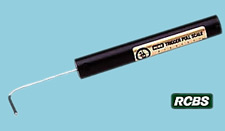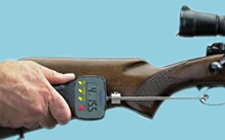Home | Glossary | Resources | Help | Contact Us | Course Map
Archival Notice
This is an archive page that is no longer being updated. It may contain outdated information and links may no longer function as originally intended.
Trigger Pull
There are three commonly used methods to determine trigger pull:
- Trigger weights
- Spring scale
- Digital scale
Laboratory protocols may determine the method that should be used to measure trigger pull.
| Note: |
| When testing the trigger pull of a revolver, each chamber of the cylinder should be measured, noting any variations. |
Trigger Weights
Trigger weights are the most commonly used method of determining trigger pull. The system consists of a shaped rod and different sizes of metal weights (usually , , 1, 2, and 5 pounds) placed on a flat surface (rest).
The steps in measuring trigger pull with trigger weights are as follows:
- For single-action trigger pull, cock the firearm. For double-action trigger pull, do not cock the firearm.
- Place the trigger under the top portion of the rod.
- Slowly lift the firearm upward with the rod, bringing force on the trigger.
- If the weights come off the rest without the firearm discharging, add more weight to the rod.
- If the firearm discharges before the weights come off the rest, remove weight from the rod.
- Continue until the least weight required to cause the firearm to discharge without the weights leaving the rest is determined.
See the YouTube Terms of Service and Google Privacy Policy
Scales
The steps in measuring trigger pull with a spring scale are the following:
- Cock the firearm.
- Attach one end of the scale to a fixed object and position the other end against the trigger.
- Slowly pull away from the fixed object until the firearm discharges.
- Record the pounds of pressure required to discharge the firearm as indicated on the scale.
Digital trigger pull scales operate in a similar way to spring scales. Calibrate and use digital scales as specified by manufacturers instructions.
Additional Online Courses
- What Every First Responding Officer Should Know About DNA Evidence
- Collecting DNA Evidence at Property Crime Scenes
- DNA – A Prosecutor’s Practice Notebook
- Crime Scene and DNA Basics
- Laboratory Safety Programs
- DNA Amplification
- Population Genetics and Statistics
- Non-STR DNA Markers: SNPs, Y-STRs, LCN and mtDNA
- Firearms Examiner Training
- Forensic DNA Education for Law Enforcement Decisionmakers
- What Every Investigator and Evidence Technician Should Know About DNA Evidence
- Principles of Forensic DNA for Officers of the Court
- Law 101: Legal Guide for the Forensic Expert
- Laboratory Orientation and Testing of Body Fluids and Tissues
- DNA Extraction and Quantitation
- STR Data Analysis and Interpretation
- Communication Skills, Report Writing, and Courtroom Testimony
- Español for Law Enforcement
- Amplified DNA Product Separation for Forensic Analysts




